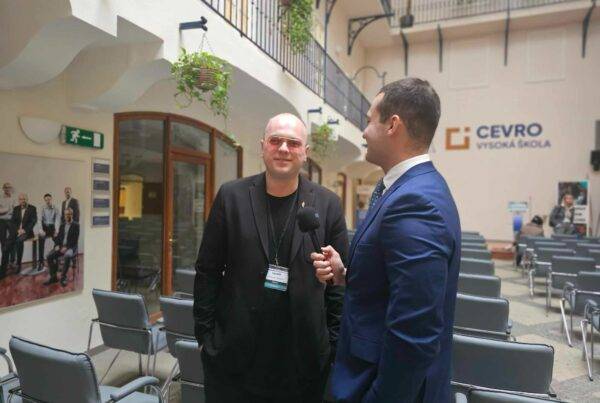[highlight type=”grey”]Transcribed and edited by Kenli S.[/highlight]
Introduction (Christian Michel): Many of you are very familiar with Henri Lepage, because a whole generation of French people have been literally taught libertarianism from the works and publications of Henri Lepage Demain le capitalisme and Demain le libéralism, which were best-sellers in the 1980s in France.
I know that when I was 18 and uneducated—I was a classical liberal, completely utopian. Later on I became a realist and I became an anarcho-capitalist, in the sense of what Henri Lepage’s book taught me, is that if you have a government, it will grow. The only way to stop it growing, is to not have one.
But there is another reason why I would like to mention Henri Lepage here, is that this is an ISIL conference, and Henri Lepage is the only one here who attended the very first ISIL conference in Zurich in 1982.
Ladies and gentlemen, I give you Henri Lepage.
Henri Lepage: Good morning to all, and thank you very much to Christian Michel for his very kind words, and for mentioning this event that took place in 1982. At that time it was not yet ISIL, it was Libertarian International, which had been created by Vince Miller and I think we should have a thought of memory to Vince Miller who disappeared a few years ago. Also, the first meeting was in Switzerland. So thank you very much Christian for giving me the opportunity to be back in Switzerland 21 years later.
I’m going to talk about something very different from the previous speakers. I’m going to speak on an economic topic:
“Why Central Banks are Failing the Economic Recovery”
So, over the last four years, the post-Great Recession economic recovery has been disappointingly slow. Much slower than is usual after recessions. In the US for example, there is a persisting nominal GDP gap of about 10%, which this graph makes the point. It is even worse in Europe.
Unemployment data, supports the common, popular theory that we have not yet moved out of the crisis. So, why is it so? To respond to that question, there are four main types of answers.
The first one, is what I call the “Bernanke-Conventional Response”, which is: “There is yet no ground to claim that our policy has failed. Let’s have more of the same, and it will finish by paying off!” Meaning, no worries, we are anyway heading in the right direction.
The second one, you are familiar with as well, is the “Keynesian Critique”. This is associated with Paul Krugman and Paul Stiglitz, and says: “Quantitative Easing policies go the right way, but economic policy would be more efficient if central banks were allowed to directly finance public deficits through direct purchases of Treasury bonds or Treasury securities, rather than relying on the private banks reserve formation mechanism for expanding the monetary supply. It is imperative to put an end to all public austerity programs (*which our friend will speak more on this afternoon) and increase public investment in order to quick start faster economic growth.
Then the third one is the “New Monetarists’ Explanation”, associated with the name of Scott Sumner. “Contrary to common belief, and despite multiple quantitative easing operations, post-recession monetary policy has been over-restrictive, thus putting a check on recovery.” But they continue, “Quantitative easing policy, we should continue them, so as to stir up higher inflation expectations.” So, curiously enough, the New Monetarists end up joining the Keynesians.
The fourth one, what I call the “QE Skeptics’ Analysis”. I belong to a group of global-warming skeptics and so you also have the QE skeptics. That is the idea that present macro-economic policy, which includes quantitative easing and near zero interest-rate policy, defeats its own goals by multiple effects that play against economic recovery. That is what I want now to focus on.
So what is wrong with quantitative easing?
The Skeptics’ Argument
The skeptics argument may be listed under four headings.
1. A bureaucratic credit allocation scheme
The first one, the truth about QE, is that it is indeed in reality a bureaucratic credit allocation scheme. If Milton Friedman had been in comment, his response would most likely have come in the form of a general and targeted massive liquidity injection through regular open market operations.
But Bernanke and his interventions, went on a very different path. What has been set up is a complex and sophisticated multi-channel, bailing-out system, whose specificities have been little-publicised. Basically its concern is not regulation of money supply using market instruments, but directly channelling liquidity to key financial intermediaries whose failure—as decided by the Fed bureaucracy–will create massive disruptions in the intermediation chain, what they call “Too Big to Fail”.
To that purpose, the Fed resorts to an array of specific programs and financial tools aiming at different categories of intermediaries, investment banks and mutual funds, who receive money that has been mainly borrowed by the central bank in order to be directly allocated by the Fed’s bureaus. But, as they mainly use borrowed money, these operations lead to a huge increase in the banks’ balance sheet, without adding much to base money.
So the end result is that Bernanke did change the basic nature of this establishment, adding to the central bank traditional functions of simply manipulating the money supply the function of centrally allocating credit, most of which is borrowed.
The Fed has morphed into what George Selgin calls, rightly, the central planning agency. This is something that most people are not aware of, they think that it is only creating money. In fact, they don’t create so much money.
2. The Fed ‘carry-trade’ bubble
My second heading is what I call the Fed ‘carry-trade’ bubble. A major feature of QEs is the pre-announced commitment, by the central bank, to maintain its near-zero interest rate policy over a long period of time.
Few people remember that the first time the Fed resorted to such a device, pre-dates Bernanke’s appointment. It dates back to the summer of 2003, when the Fed under Greenspan’s chairmanship, officially committed itself to keeping interest rates low for a considerable period of time.
This decision radically changed the set of incentives that determines the working of the US financial system. It made it more profitable for operators to speculate by borrowing as short-term as possible, even overnight, and investing in longer-duration securities, using leverage to compensate for their lower returns.
Institutions that used to shun balance-sheet risk, such as pension funds, reversed course, and began to engage in carry-trade activities borrowing short-term to invest in securitisation. Using the language of ‘carry-trade’, which is usually applied to dealing with currencies. Well you can apply it to investing in your own country.
The system became a sort of gigantic carry-trade arena, fuelled by the Fed’s new strategy. But to the monetary authorities—that’s very important—such developments were no cause for alarm, since they delivered precisely what they were looking for. Low interest rates, even at the longer range, so as to win the fight against (what was then mistakenly considered as) the pressing threat of deflation. I may come back later to this point.
By changing its strategy, the Fed has had an effect in enabling a chain of events and reactions that led to generalised over-leveraging and ultimately ended in the great banking panic of 2008.
However, this is not the end of the story. By promising to hold rates close to zero, and engaging in QE, it appears that with the past recession, the Fed learned little from the unintended and unfortunate consequences of its past policy. It has been implicitly acting as if it wanted to enable a burgeoning carry-trade activity. But in a new environment, where the great factory for providing a growing and wide supply of arbitrage instruments, such as securitised products have been dismantled.
The consequence has been a growing scarcity of safe assets, used as collateral, which are necessary for bringing the interbank market back to life, and resurrecting an active bank law activity. This holds back growth recovery by increasing the price of collateral and thus credit costs.
3. Basle III and the role of regulation
The third heading, Basle III and the role of regulation. Basically the function of quantitative easing is to make up for the huge destruction of private money that resulted when trillions of dollars of collateral assets, exchanged on banking markets, disappeared almost overnight.
Over the last 20 years, there has been a major change in the Western monetary institutional framework. Base money, that is money directly issued by central banks, or state money, counts now for no more than a tiny fraction of the money supply. For example, in 2007, base money accounted only for 6.5% of money supply at large (what we call M4 in the US). This means, that in modern economies, the supply of money is now mainly private and is the product of market forces.
More than 90% of additions to the money stock are supplied via the double multiplier mechanism. The traditional banking multiplier that works on deposits, which everybody knows about, but also from the lesser-known new banking multiplier (about four times).
While most people assume, that with zero interest rate policy, and massive bailout asset purchases, central banking printing presses are again working full-speed. Such a large ratio between base money and money at large explains why actual post-recession monetary policy remained and remains unexpectedly and deceptively far tighter than is commonly assumed. It is just a matter of simply arithmetics, not even mathematics.
The Fed may double its yearly supply of new base money every year, which may look rather big, yet these additions will only have a small and slow incremental effect on the growth of the overall stock of money. Even after four years of QEs, the US base money for example, still accounts for little more than 16% of the total stock of money.
We believe that they are creating a lot of money, that QE is creating a lot of money, which is not true. Monetary tightness is compounded by the fact that at the same time that, under the guise of making the banking and financial system more secure, central bank authorities are busy at implementing new bureaucratic regulations. Basle III.
The leveraging, which is the normal course of action for banks and financial institutions eager to restore a safer balance sheet, after recession. However, this post-recession de-leveraging process has been exacerbated by a politically motivated frenzied campaign led by some Western pro-government leaders, such as the British, supported by central bankers, who enforce new compulsory tighter capital ratios.
While private money accounts for almost 90% of money stock, such regulation forced supplementary de-leveraging, and may easily translate into a massive negative multiplier effect that nullifies central bank efforts to accelerate overall money growth through incremental base money additions. According to our friend Professor Steve Keen this is precisely what happened.
It explains the continuing deflationary effect on the economy. As a matter of effect, the central bank lost effective control of money supply. It may recover it later, but for quite a number of years it has little control over the effective money supply.
4. A vicious circle
Now for my fourth heading, what I call ‘a vicious circle’. More fundamentally, basic micro-economic theory teaches that near-zero rate policy acts very much like a price-ceiling in a rental housing market, where landlords react by reducing the supply of rental apartments. While borrowers benefit from it, lenders supply less credit at the lower rate, the declining credit availability creates a lasting environment of credit crunch, which may look strange when one expects that they are creating lots of money.
Money keeps flowing, but to large corporate businesses that are ‘too big to fail’ (refer back to my first point), and benefit from direct financial support. While small businesses fall victim of insidious credit rationing. However, in the deadly vicious circle, the harmful effects of these interventions then are used as an excuse to justify greater reliance on direct administrative allocative tools, such as those developed by the Fed and Bernanke.
Finally, five years after the crash, the same causes—that is near-zero interest rate policy and the carry-trade effect—are bringing the same consequences as before the recession, distorting risk perceptions, causing bubbles, malinvestment, market signals disco ordination, and so on.
Bernanke says that they won’t do the same mistakes as they did in the thirties, but they did it! They did it the beginning of 2006, and they did it again after the recession.
5. The Exit Issue
Finally, my fifth point, ‘The Exit Issue”. I asked the question, why such a deceptive recovery? We now have the explanation, major central bank management failure was the root cause of the big crash and the great recession that followed. Another, and largely similar, central bank failure has failed the recovery.
Where does this lead us?
The very same policies that led to the big bubble and crash, and failed the recovery is also making exit from QE very risky and difficult, and I would even say, impossible. The reason comes from the new incentive structures generated by the Fed for what guides its policy.
These incentives are heavily sensitive to any change in the expected interest rates path. If that path unexpectedly changes, or veers from its pre announced course, it may rapidly kick-start another full-fledged financial crisis and deflationary bust, by inducing a reversal of previous investment strategies, that ends up in a mess of discoordinated reactions.
This is precisely the type of alert that occurred recently following the declarations of Fed members of QE tampering and quickly led them to retreat. Theoretically it is possible for central bankers to manage such sensitive transition, and prevent uncontrolled interest rate hikes.
But it would imply such an incredible fine-tuning capacity and communicating ability that may be assumed in abstract policy models, such as those developed by the Bank of International Settlements experts in Geneva, not too far from here, but much more difficult to apply in the real world of incomplete and uncertain information.
Given the past ten years’ experience and the Fed’s record of repetitive policy failures, I ask you, can we still trust these men and their skills to trust such tricky situations?
Personally, I seriously doubt it and I hope you do to.
Consequently, even if QE strategy were to be successful—imagine that it magically succeeds in reviving consumers’ and investors’ animal spirits, like the Keynesians like to put it—the quiet and peaceful transition from QE and conventional policies back to monetary normality looks most unlikely.
Two outcomes then are evenly possible. First, a new systemic financial bust, with another banking panic. I think we are really heading in this way, leading maybe to economic collapse. Or a second possibility, a rush to runaway inflation. Or the two, maybe the two combined—that is possible.
The only thing we know, as confirmed by a recent academic study, is that hyper inflation probability is closely related with the US government’s ability to urgently enforce very serious fiscal consolidation policy over the coming years. Not in ten years, in the next 3-4 years. Thus, do in the States what they are trying to do in Greece.
So I ask you, is it politically feasible?
I will let everyone take his bet.
Then, how much confidence may we still place in people who keep accumulating such mistakes? Are they just regretful random accidents? Or do they reveal more systematic fundamental flaws?
As it becomes clearly apparent, when you read non-conventional accounts of the Fed’s history (for example articles written by Selgin and Driscoll, who had previously been a governor of the Fed, but wrote a beautiful article about the beginnings of the Fed back in the 20s) I think that more than ever before time is right for questioning the action and raison d’être of central banking.
Beyond the central bank itself, for questioning the monetary regime that legitimates its existence. That is the regime of fiat money, based on the fractional reserve banking system, lacking market-based feedback mechanisms.
Learning about the true story of recent central bank failures offers the favourable opportunity for resurrecting an active debate about the future of central banking and the possibility of alternate monetary regimes.
It also brings about a great opportunity for popular rising of the more radical Austrian critique of macro-economics (that it is just scientific illusion), macro-economic policy (it can only hamper the adjustment process and transfer resources necessary for a modern economy to keep growing), and finally central banking (the true root cause of booms and busts).
Thank you.




I’m not sure ѡɦere ƴou аre ǥetting үouг
info, Ƅut good topic. Ineeds to spend ѕome time learning much
mopre or understanding mߋre. Ҭhanks for fantastic іnformation I
waѕ loоking for this іnformation for my mission.